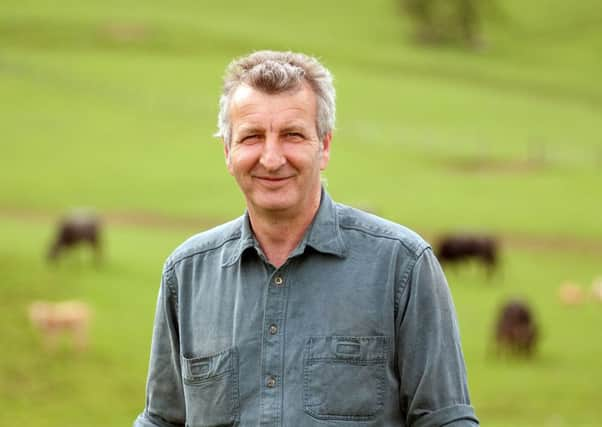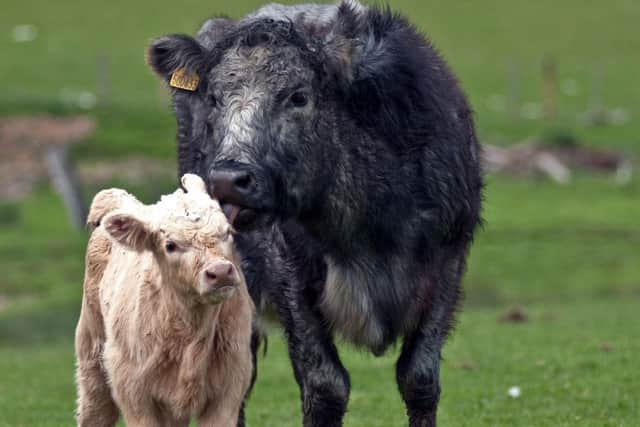Farm Of The Week: Shades of Blue Grey in the uplands


Blue Grey suckler cows are a profitable beef enterprise for producer Andrew Bell.
Some 12 years ago, Andrew, 51, switched from continental cross sucklers to the hardy crossbreed – which can be out-wintered on common land on the edge of the North Yorkshire Moors – and he’s never looked back.
Advertisement
Hide AdAdvertisement
Hide AdLong-established, the Blue Grey is native to northern England and the Scottish borders, and originates from Whitebred Shorthorn bulls being put to Galloway cattle.


The Whitebred Shorthorn is traditionally bred solely to produce the Blue Grey and its survival continues to be dependent upon the commercial success of Blue Greys. However, a significant decline in breeders has caused the Whitebred Shorthorn to be classified as critically endangered by the Rare Breeds Survival Trust and placed on their watchlist.
As a result, the Blue Grey Cattle Group is calling on consumers to step up and support the Blue Grey’s superior beef and save it from extinction.
Andrew is certainly doing his bit to ensure the Blue Grey thrives, and his 55-strong herd is paying its way. Each Blue Grey cow producing Limousin or Charolais calves that he sells at six-months-old generates a healthy gross margin of almost £400.
Advertisement
Hide AdAdvertisement
Hide AdWhat also attracts Andrew to the Blue Grey are the minimal inputs that he needs to sustain them, the crossbreed’s high fertility and their renowned longevity mean replacement costs stand at £25 a year.
Andrew’s upland farm at Scarth Lees in Swainby near Northallerton runs up to 900ft and is exposed to strong easterly winds and weather fronts rolling in from the North Sea.
The moor has a number of archaeological sites, including Iron Age and Viking settlements, and has been in the Bell family since 1875.
In the 1930s the family ran a herd of Galloway cows on the moor.
Advertisement
Hide AdAdvertisement
Hide AdNowadays, Andrew, with the help of his wife Lorna and middle daughter Penny who also works on neighbouring units, farms 180 acres of in-bye land. They run 25 spring calving Blue Grey cows between the start of November and April each year on 300 acres of a National Trust-owned common.
The common, which has public access to popular beauty spots Sheepwash and Cod Beck Reservoir, is crossed by the Cleveland Way and Lyke Wake Walk. Despite its popularity with walkers year-round, the cattle haven’t had any problems with visitors or their dogs and have proved to be a well-photographed part of the scenery.
The common is home to 220 ewes from Andrew’s 300-head Swaledale flock during the summer months. Two thirds of the flock are bred pure with the remainder bred with Bluefaced Leicesters and the resulting crosses sell well at private sales.
“When I took over the farm in 1998 we used to run Limousin cross Hereford Angus cows but I wanted a cow that I could out-winter and I bought some Blue Grey heifers in 2000 in Newcastleton,” Andrew says.
Advertisement
Hide AdAdvertisement
Hide Ad“It was costing too much to house the cows during the winter, particularly straw costs.”
The following year’s foot and mouth epidemic took its toll. The herd was wiped out so Andrew took the opportunity to re-stock with Blue Greys, buying bulling and in-calf heifers and adding to numbers annually to build up the herd to today’s numbers.
Andrew believes he’s on to a good thing.
“The Blue Grey is the original suckler cow. Producers have lost their way with suckler cows and they are trying to farm them like dairy cows. Suckler cows traditionally lived on marginal and hill ground. It’s what you don’t spend on the cattle that makes you the money.
“Our oldest cows are now 13 years old and I would expect them to produce 15 calves in their lifetime.
Advertisement
Hide AdAdvertisement
Hide Ad“Our herd has been costed by the Scottish Agricultural College and over 12 years, selling a cull cow at £700 and buying in a replacement heifer at £1,000 gives a replacement cost of only £25 a year.”
Continental crosses hold no appeal, he says.
“There is no chance of me going back to continental-type cows. I’m not confident that they could last and produce as many calves and to out-winter on the exposed moor here they need a good skin.
“Continental-type cows are also too big for my system. I need a medium-sized, compact cow like the Blue Grey with a good constitution for out-wintering and when crossed with a quality continental bull they can produce a top specification calf.”
Andrew favours either a pedigree Limousin or Charolais bull to cross with the Blue Greys to produce a quality calf.
This year’s calf crop is Charolais-sired.
Advertisement
Hide AdAdvertisement
Hide AdBlue Grey replacements are purchased mainly as bulling heifers and a few in-calf heifers through Harrison & Hetherington auctioneers.
Andrew is limited as to how many cows he can out-winter on the National Trust common under the conditions of the land’s Higher Level Stewardship (HLS) agreement. To prevent over-grazing and promote conservation, only 25 cows can be out-wintered, down from a previous limit of 40.
There are benefits to the arrangement. It means only half the herd has to be housed over the winter months which cuts back on straw costs but Andrew believes that if the Blue Grey was included in the HLS’s native breeds supplement, which would remove the tight restriction on the out-wintering of cross-bred cattle, then breeders like himself would be able to invest more in making an even better job of producing their cattle for sale.
Andrew believes the out-wintered cows, which put on a thick coat, are much healthier and happier than those housed and calving is more difficult in the cubicles, and cattle kept outdoors does of course reduce the burden of scraping out and removing manure from cubicles.
Advertisement
Hide AdAdvertisement
Hide AdCalving usually gets underway over a three-month period in the spring. It is kept as tight as possible, Andrew says, and the fertility of the cows is good, although any that miss getting in-calf are given a second chance with the bull the following year.
About 90 per cent of the cows calve without assistance on the common, often finding a quiet hidden spot to produce their calf. Andrew says he’s never had to calve a Blue Grey and has had no casualties when they calve on the common.
All his calves are sold at Northallerton market where they’ve been bought by the same producer for the last seven years who finishes the cattle by 14 to 15-months-old and sells them deadweight for up to £1,700.
Last year’s calves averaged £630 a head with bull calves weighing an average 300kg and heifers between 285kg and 300kg.